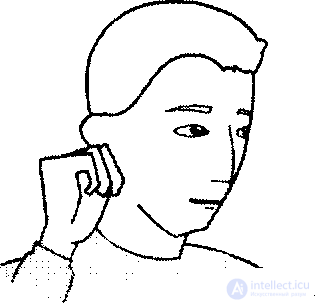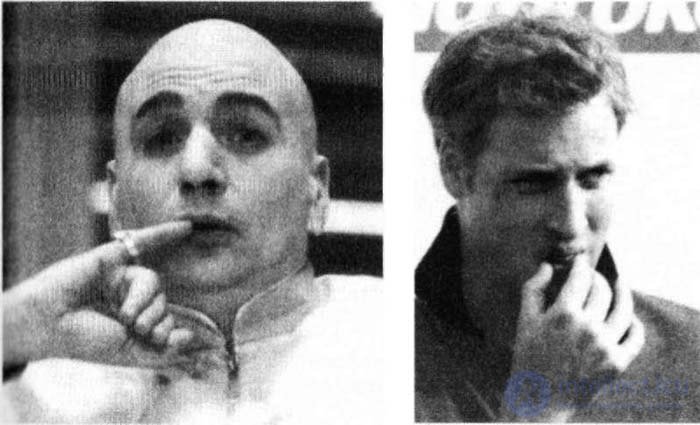Lecture


Sometimes people cover their mouths with one finger, as if calling for silence. Most likely, the parents of such a person often used this gesture when he was small. In adulthood, he uses it in an attempt not to give out his true feelings. Such a gesture immediately makes it clear that the interlocutor is hiding something.
2. TOUCH TO NOSE

Sometimes a person touches the tip of the nose with a light, almost imperceptible movement, sometimes vigorously rubs the space between the upper lip and the nose. Women make this movement more imperceptibly than men, probably fearing to ruin their makeup.
It is very important to remember that such a gesture should be interpreted only in connection and in context. It is possible that your partner just a cold.
Scientists have discovered that when a person lies, they produce substances called catecholamines in his body that act on the nasal mucosa. With the help of special equipment, scientists were able to control the blood flow in the body and came to the conclusion that intentional lies also lead to an increase in blood pressure. From this we can conclude that the liars do have an enlarged nose, which leads to the so-called "Pinocchio effect." High blood pressure affects the nose and nerve endings located in it. The nose begins to itch, and the person involuntarily rubs it.
It is impossible to notice an increase in the nose with the naked eye, but it is very difficult to hide the touch on the nose. The same thing happens when a person is alarmed, offended or angry.
American scientists - neuropathologist Alan Hirsch and psychiatrist Charles Wolf conducted a thorough analysis of Bill Clinton's speech to the Grand Jury during the analysis of his relationship with Monica Lewinsky. Scientists have discovered that when the president spoke the truth, he barely touched his nose. When Clinton lied, he frowned for a moment before answering and touched his nose every four minutes. Hirsch and Wulf counted 26 touches. When Clinton answered honestly, he did not touch his nose at all.
Studies conducted with the help of special equipment have shown that when a man lies, his penis is filled with blood and enlarges. Maybe the Grand Jury should have taken off Clinton's pants?

| Prosecutor: "Mr. Clinton, why did the chicken cross the street?" Bill Clinton: “What do you mean by saying" chicken "? Could you clarify the concept of "chicken"? And personally, I did not cross the streets with this chicken! " |
3. WHAT CAN YOU SAY ABOUT THE ZUD IN THE BOW?
Usually, itching in the nose passes after vigorous scratching or rubbing. In this way, such a gesture is different from touching the nose, which we just talked about. As in the case of fixing the mouth, the speaker can touch the nose, trying to hide the deception, and the listener who doubts what has been heard. Scratching the nose is usually an isolated, repetitive gesture. It is not combined or falls out of context of the general conversation.
4. WIPE EYE
“I see nothing,” says one of the wise monkeys. When a child does not want to look at something, he closes his eyes with one or both of his hands. When an adult does not want to see something unpleasant, he begins to rub his eyes. Such a gesture indicates an attempt by the brain to block deception, doubt or an unpleasant sight.
Men usually rub their eyes vigorously, as if deception is a speck that fell into their eyes. Women rub their eyes much less often. Instead, they lightly touch the lower eyelid, which is not surprising, since they do not want to spoil the makeup. In this case, women also look to the side.

“Lying through teeth” is a fairly common expression. By this is meant the whole chain of gestures: clenching of the teeth, fake smile and rubbing of the eyes. Such a chain is often used in movies to depict insincerity. It is also quite common, for example, in England, since the British almost never speak to the interlocutor about their thoughts.
5. wiping the earlobe

Imagine what you are saying to a person: “This product costs only three hundred pounds,” and he starts rubbing his earlobe, looking away, but at the same time he says: “It sounds tempting.” Human gestures give out a symbolic attempt to “hear nothing”. He tries to block what he heard, putting his hand to his ear and rubbing his lobe. There is an adult version of a child gesture: when a child does not want to hear the accusations of adults, he covers his ears with both hands. Some people begin to rub their necks behind their ears, pick their ears, stretch the lobe or twist the ear so that the shell covers the auditory opening.
Rubbing the ear indicates that the person has heard enough or wants to say something himself. This gesture, like touching the nose, is used by people who feel anxiety. Prince Charles often rubs his ear and touches his nose when he enters a hall filled with people or passes by a crowd. These gestures betray his anxiety. But we have never seen pictures of such gestures when Prince Charles is inside his car, that is, in relative safety.
In Italy, rubbing the ear means that the man is homosexual or simply looks too feminine.
6. NECK HANDLING

The index finger (as a rule, the hand with which the person writes) scratches the neck under the ear lobe. Our observations show that an average person scratches his neck five times. Very rarely, the amount of scratching is less than five. Only five are scratching their necks more than five times. This gesture betrays doubt or uncertainty. The person as if speaks to you: "I am not sure that I can agree." This gesture is especially noticeable when the words of a person contradict him. If a person says: “I can understand what you feel,” but at the same time he scratches his neck, then he has no idea what it is to you now.
7. PULLING UP THE COLLAR
Desmond Morris first discovered that a lie causes tingling in the tissues of the face and neck, so the person begins to scratch and rub them. Now it becomes clear why insecure people constantly scratch their necks. Speaking lies and fearing to be caught in a lie, some ottyagivayut collar, as if they are hot. Deception leads to an increase in blood pressure and increased sweating, especially aggravated in cases where the cheater is afraid of being caught.

The same gesture appears when a person is angry or depressed. He unconsciously delays the collar to cool down a bit. If you see that the other person is delaying the collar, ask them to repeat or clarify what was said. This make the cheater ponder over his actions and, perhaps, tell the truth.
8. FINGERS IN THE MOUTH
This is an unconscious attempt by a person to return to a state of security, memorable to him from infancy, when he sucked the mother's breast. Such a gesture occurs when a person feels under pressure. A small child replaces the mother’s breast with a thumb or blanket. An adult person sucks a finger, a cigarette, a pipe, a pen, a shackle of glasses or chews a gum.
Most mouth touches involve deception and lies. However, a finger in the mouth indicates that a person has an inner need for encouragement. Support the interlocutor, give him certain guarantees - and this will allow you to move in a positive direction.

Comments
To leave a comment
Body language
Terms: Body language